Among the various ways of measuring investor sentiment, the BAML survey of global fund managers is one of the better as the results reflect how managers are allocated in various asset classes. These managers oversee a combined $600b in assets.
The data should be viewed mostly from a contrarian perspective; that is, when equities fall in price, allocations to cash go higher and allocations to equities go lower as investors become bearish, setting up a buy signal. When prices rise, the opposite occurs, setting up a sell signal.
To this end, fund managers became very bullish in July, September, November and December, and stocks have subsequently sold off each time. Contrariwise, there were some relative bearish extremes reached in August and October to set up new rallies. We did a recap of this pattern in December (post).
Summary: In May, fund managers reduced their cash to 4.5%; in 7 of the 8 times cash has been at this level (or lower) in the past two years, the SPDR S&P 500 ETF (ARCA:SPY) has fallen the following month, usually by around 5%. Allocations to equities are near their highs but mostly because fund managers are about 1.4 standard deviations overweight both Europe and Japan. In comparison, they are nearly 1 standard deviation underweight the US. In the past, this has been a set up for US equities to outperform on a relative basis.
Let's review the highlights:
Fund managers reduced their cash levels to 4.5%. While this is relatively high on a historical basis, note that cash levels haven't been much below 4.5% since early 2013. In other words, cash levels suggest fund managers are bullish, a contrarian warning. 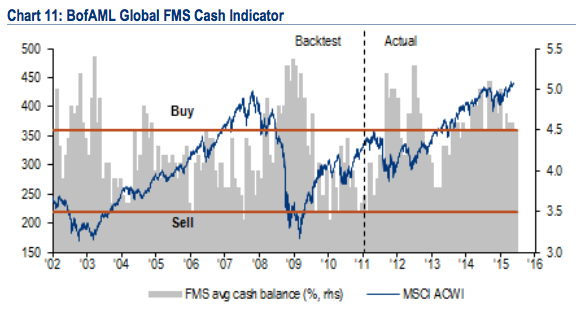
What is noteworthy is that cash has fallen to 4.5% (or lower) 8 times in the past 2 years; SPY has usually fallen around 5% in the following month. There was one exception (green shading) and SPY instead fell two months later. On a relative basis, cash levels are a cautionary signal.
Fund managers are +47% overweight equities, down from +54% in April and +58% in March which was the third highest since the bull market began six years ago. Prior to this month, their equity exposure has been 1 standard deviation over the long term mean for three months in a row for the first time in the survey's history. Under similar circumstances in the past, long equities has had a poor risk/reward profile. Similar instances are highlighted in green.
US exposure was -19% underweight in May, equal to its level in March; both are the lowest since January 2008. US equities are under-owned and should outperform those in Europe and Japan on a relative basis (see below).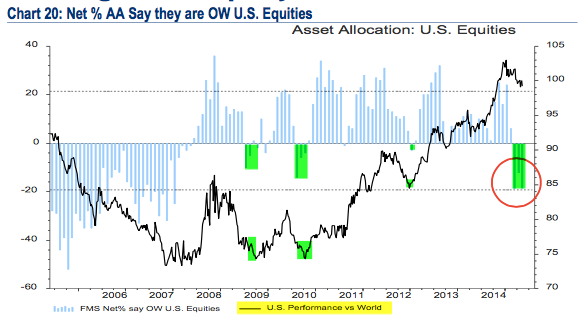
Eurozone exposure jumped massively to +60% overweight in March, the highest in the survey's history. It declined to a still substantial +49% overweight in May. Judging from the experience in 2006, European equities are likely to underperform. 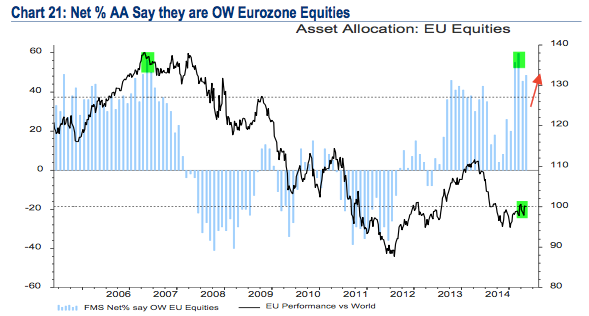
Allocations to Japan stayed near the highs of the last few months (+42% overweight). Allocations the past seven months haven't been this high since April 2006. It looks extreme. Managers expect Japan to benefit from central bank liquidity.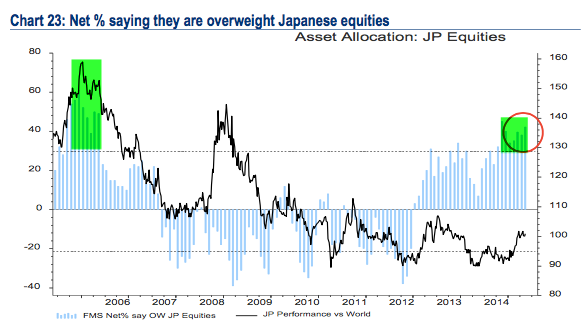
Fund managers are -9% underweight emerging markets, a small increase from April despite the region's strong performance recently. As we have said, this is where bottoms tend to form.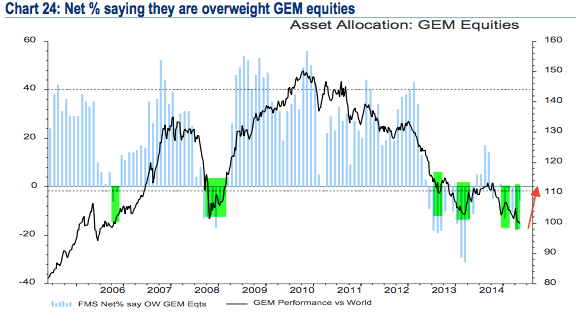
Fund managers are -60% underweight bonds, a new 9 month low. Bonds continue to be the most underweighted asset class and this, in large part, explains why cash balances have not been lower that 4.5% in two years. For comparison, managers were -38% underweight in May 2013 before the large fall in bond prices.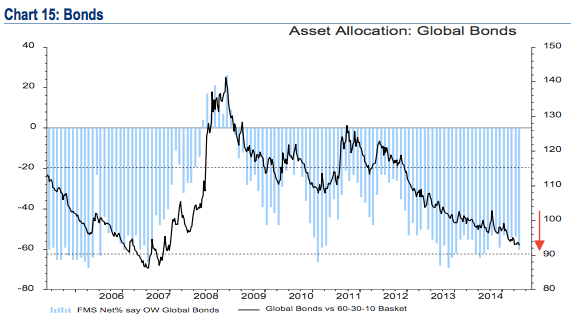
Globally, managers are not just overweight equity and underweight bonds, they are overweight the highest beta equities (technology, discretionary, banks). The largest underweights are in materials and energy.
In April, the global overweight in discretionary stocks was the highest since the survey began. It fell slightly in May but is still 2.2 standard deviations above the long term mean. This is a "risk on" measurement. 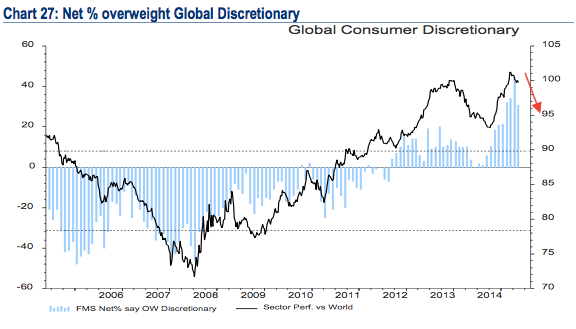
In the US, banks, pharma (biotech) and tech are the most favored sectors. This has been the case for many months. Utilities, staples, telecoms (defensives) and energy remain underweighted. This is also a measure showing fund managers are in a "risk on" posture. 
Putting all of the above together, fund managers are long equities and cyclicals relative to cash, bonds and defensives. This means that overall fund manager sentiment is "risk on" (blue line). In the past, this corresponded with weak equity performance (early 2006, 2010 and 2011 were similar). That changed starting in 2013. Since then, fund managers have maintained a "risk on" profile throughout, even as cash levels have stayed relatively high. In this respect, the BAML survey is similar to Investors Intelligence which has also shown persistently high bullish sentiment the past two years. Still, fund manager sentiment is nearing recent highs from early and mid-2014 which preceded subsequent weakness in equities.
Since 2006, fund managers surveyed by BAML has been very good at determining when the dollar is overvalued. In April, they viewed it as overvalued by the most since 2009. Similar cases are highlighted in green. The dollar has since sold off but it is viewed as overvalued relative to history.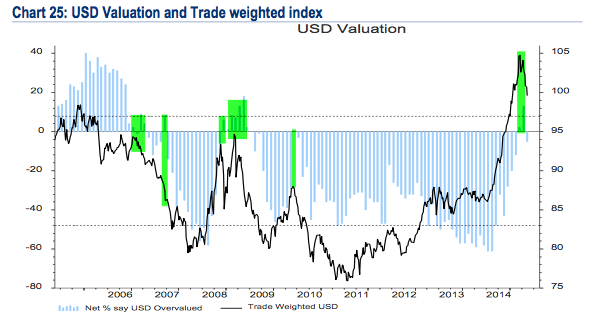
In April, only 33% of fund managers said oil was overvalued, similar to the low in oil in 2009. That extreme is now gone as just 13% in May believe oil is overvalued, the lowest in 8 months.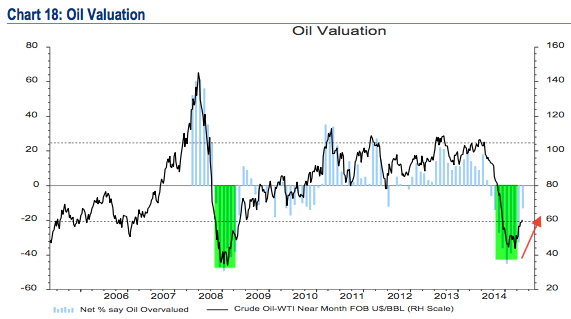
Survey details are below:
- Cash (+4.5%): Cash balances fell to 4.5%. Typical range is 3.5-5%. BAML has a 4.5% contrarian buy level but we consider over 5% to be a better signal. More on this indicator here.
- Equities (+47%): A net +47% are overweight global equities, down from +54% in April. Over +50% is bearish. A washout low (bullish) would be under +15-20%. More on this indicator here.
- Regions:
- US (-19%): Exposure to the US fell to -19% underweight, the lowest since January 2008, from -12% underweight last month. For comparison, it was +24% overweight in January.
- Europe (+49%): Exposure to Europe increased to +49% overweight from +46% overweight in April.
- Japan (+42%): Managers are +42% overweight Japan, an increase from +38% overweight last month. Funds were -20% underweight in December 2012 when the Japanese rally began.
- EEM (-6%): Managers increased their EEM exposure to -6% underweight from -18% in April, which was the lowest in the past two years.
- Bonds (-60%): A net -60% are now underweight bonds, a fall from March and April. For comparison, they were -38% underweight in May 2013 before the large fall in bond prices.
- Commodities (-14%): Managers commodity exposure increased to -14% underweight from -20% underweight last month. With the exception of August 2014, it has been less than -15% since early 2013. Low commodity exposure goes in hand with low sentiment towards EEM.
- Macro: 70% expect a stronger global economy over the next 12 months. January 2014 was 75%, the highest reading in 3 years. This compares to a net -20% in mid-2012, at the start of the current rally.
